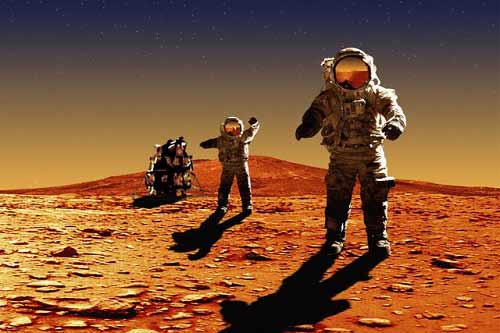When astronauts fly into space, astronauts will be thinner
In the mission of exploring astronauts, astronauts find that their skin is thinner than usual when flying into space. Scientists are conducting research to understand the cause.
The astronaut's skin is thinner when flying into space
The long-awaited mission of human exploration of the Red Planet is still expected in a few years. NASA plans their first manned journey by 2030. But with a distance of more than 55 million kilometers, astronauts face at least half a year of new travel to Mars - not to mention journey back. In the myriad of obstacles that need to be overcome, the health of the astronauts for a long time in space is the main concern.
German scientists have used advanced imaging technology to understand an unusual phenomenon: Why are astronauts' skin thinner in space? The study was led by Professor JenLab, the director of the German company, with offices in Jena and Saarbrucken, Karsten Koenig from Saarland University.
Karsten Koenig and his colleagues used high-resolution skin scans to observe the skin cells of some astronauts before and after flying into space.
Laser technology developers say the resolution in space is a thousand times higher than that of ultrasonic devices. " By using femtosecond laser pulses, we scanned the skin of astronauts and received signs from the skin, especially fluorescence, as well as another sign called the second harmonic. So, with these two signals, we can reproduce the images and have an accurate view of the skin with high resolution ".

The health of astronauts is very important in the mission of exploring the universe
"This resolution is a better factor than ultrasound. So it is possible to collect information without a biopsy. We can receive information in a few seconds. With this great resolution, "Koening added that this application includes histopathology in the human body that can diagnose cancer early and the decisive effects of skin aging.
European space agency Koening (ESA) requires the use of femtosecond laser technology for their "Skin B" project. The aviation agency that carried out the project aimed to find out " the mechanism of slow skin aging on Earth but accelerates rapidly in a weightless environment" . Until now, Koening and his colleagues swept the skin of three astronauts before and after flying into space, Italian astronaut Luca Parmitano, Samantha Cristoforetti, and German astronaut Alexander Gerst.
"Currently, we have had interesting results from three astronauts. It seems there is a strong production of collagen, so astronauts suddenly have more collagen than normal. This means There are some types of anti-aging effects, at least in the dermis, the lower part of the skin, and we found that the epidermis, especially the living cells, has shrunk, due to "The skin becomes thinner," Koening said.
Koening and his team have continued to study the causes of astronauts' thinning and more importantly, how to prevent them. " We found that the epidermis was nearly 20% thinner. And so far we have not been able to explain it. This study was done with 6-month astronauts, a big question is: Is it good for astronauts to go to Mars for a year or two if the skin is getting thinner and thinner , " Koeing said.
- The US spends $ 55 million on NASA to promote the creation of space for astronauts
- Why are astronauts forbidden to drink in outer space?
- China will let astronauts eat rice in space
- America spends more on Russian rents to bring people to space
- Astronauts welcome the new year at the international space station
- Astronauts will fly to space by ordinary airports
- Vivid images of space astronauts
- ISS first picked up 4 female astronauts at the same time
- China announced three astronauts to take on the mission of walking into space
- Astronauts are about to step outside the space station
- Astronaut walking in space
- Three astronauts depart to the International Space Station
 Green tea cleans teeth better than mouthwash?
Green tea cleans teeth better than mouthwash? Death kiss: This is why you should not let anyone kiss your baby's lips
Death kiss: This is why you should not let anyone kiss your baby's lips What is salmonellosis?
What is salmonellosis? Caution should be exercised when using aloe vera through eating and drinking
Caution should be exercised when using aloe vera through eating and drinking